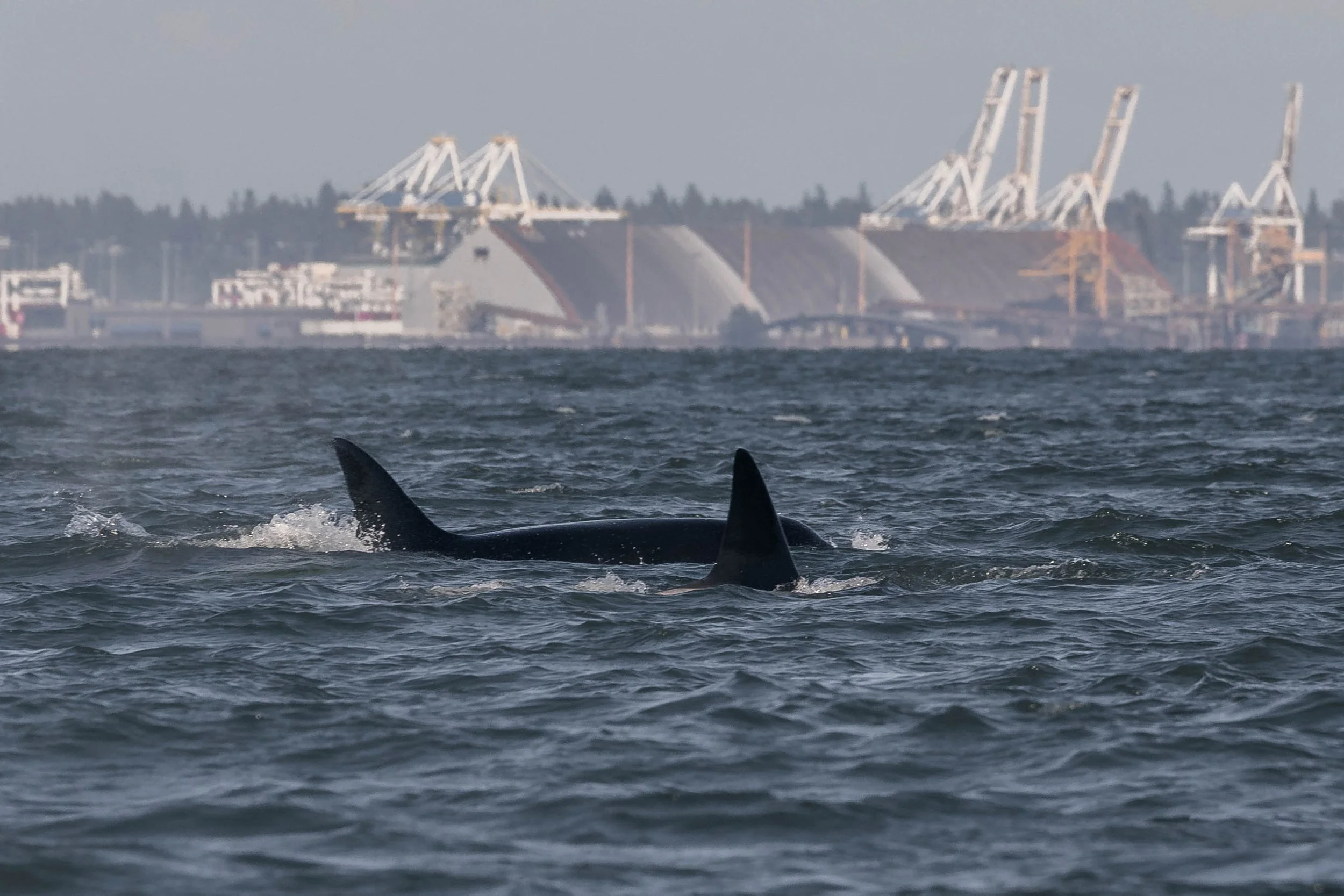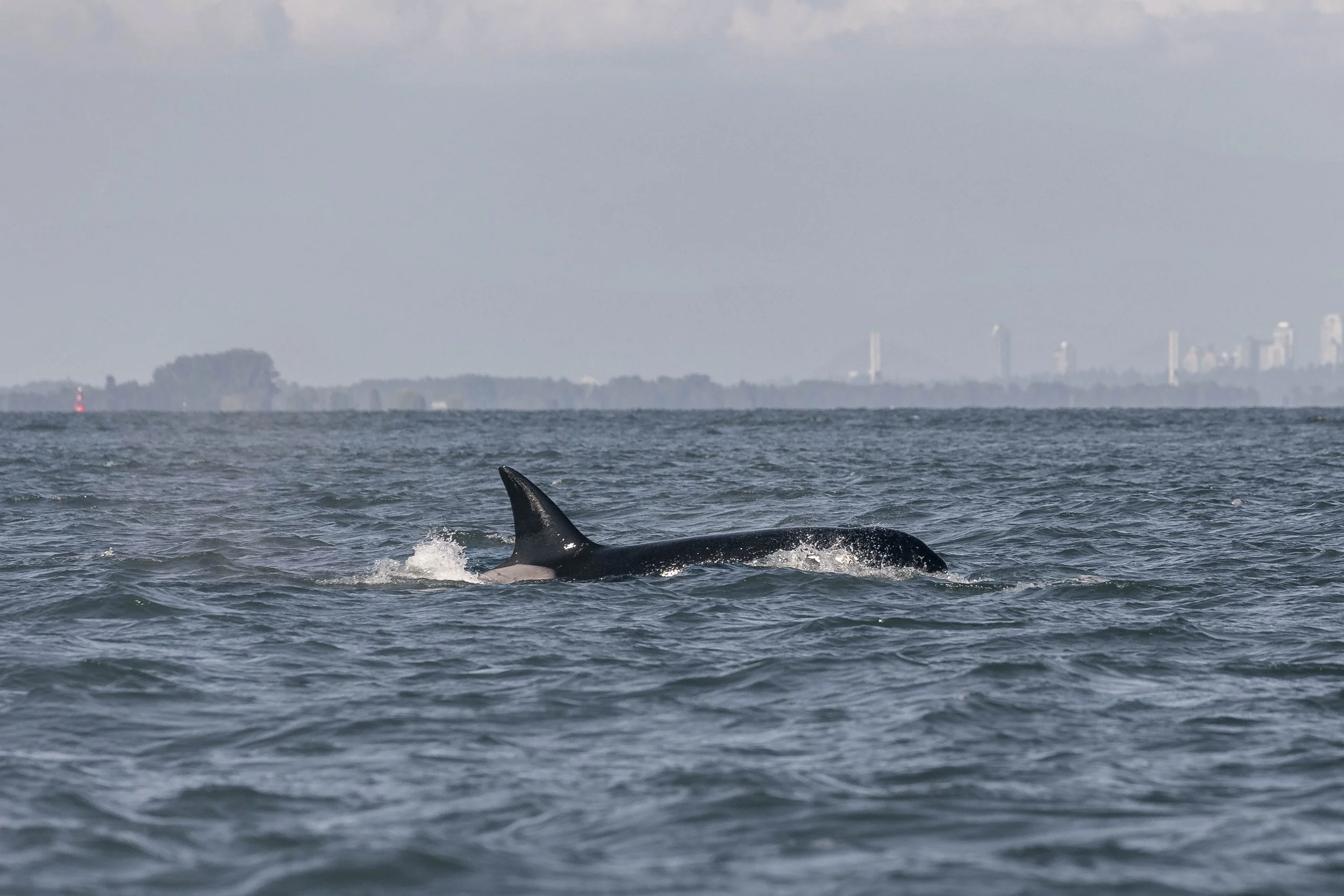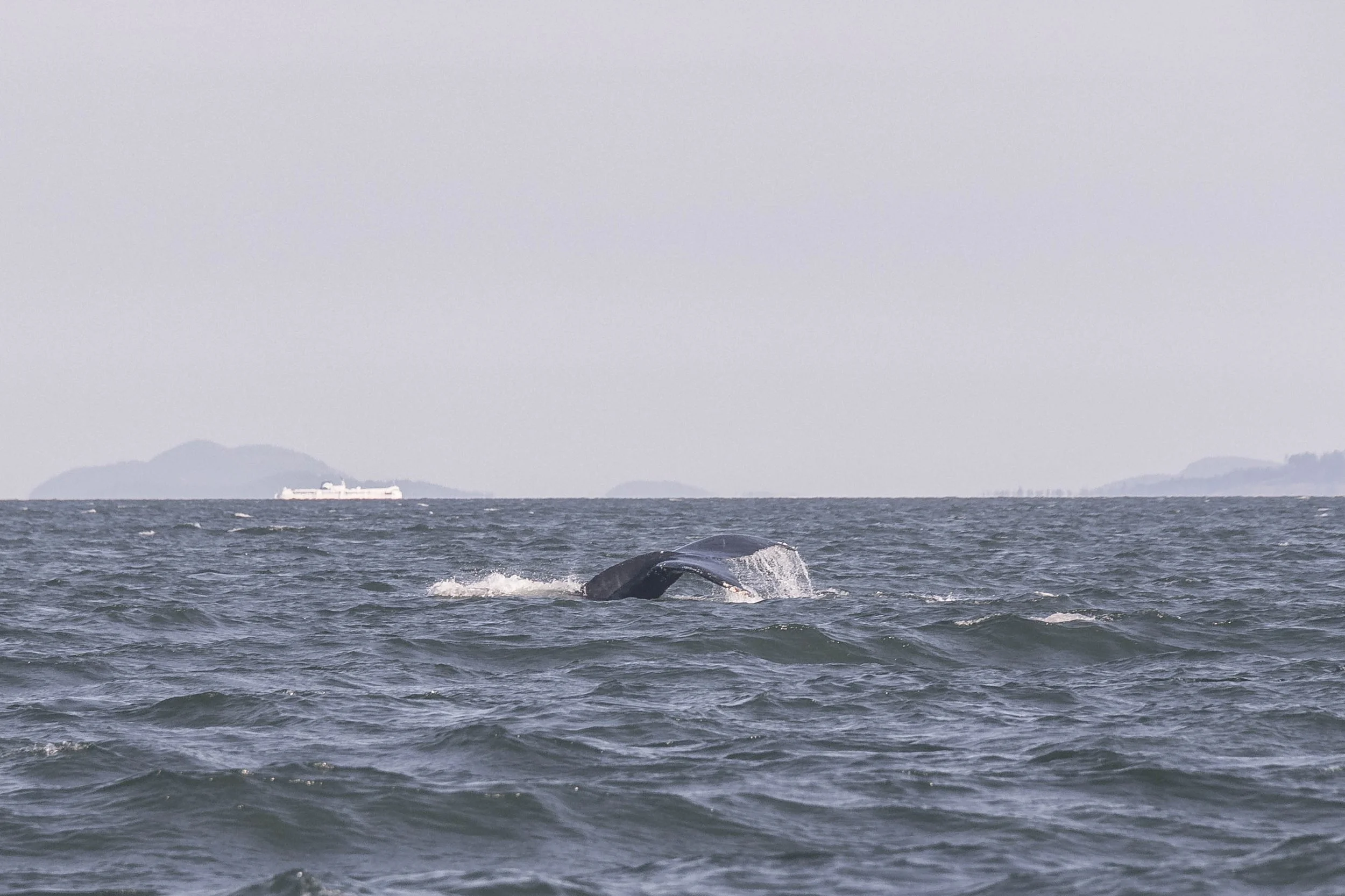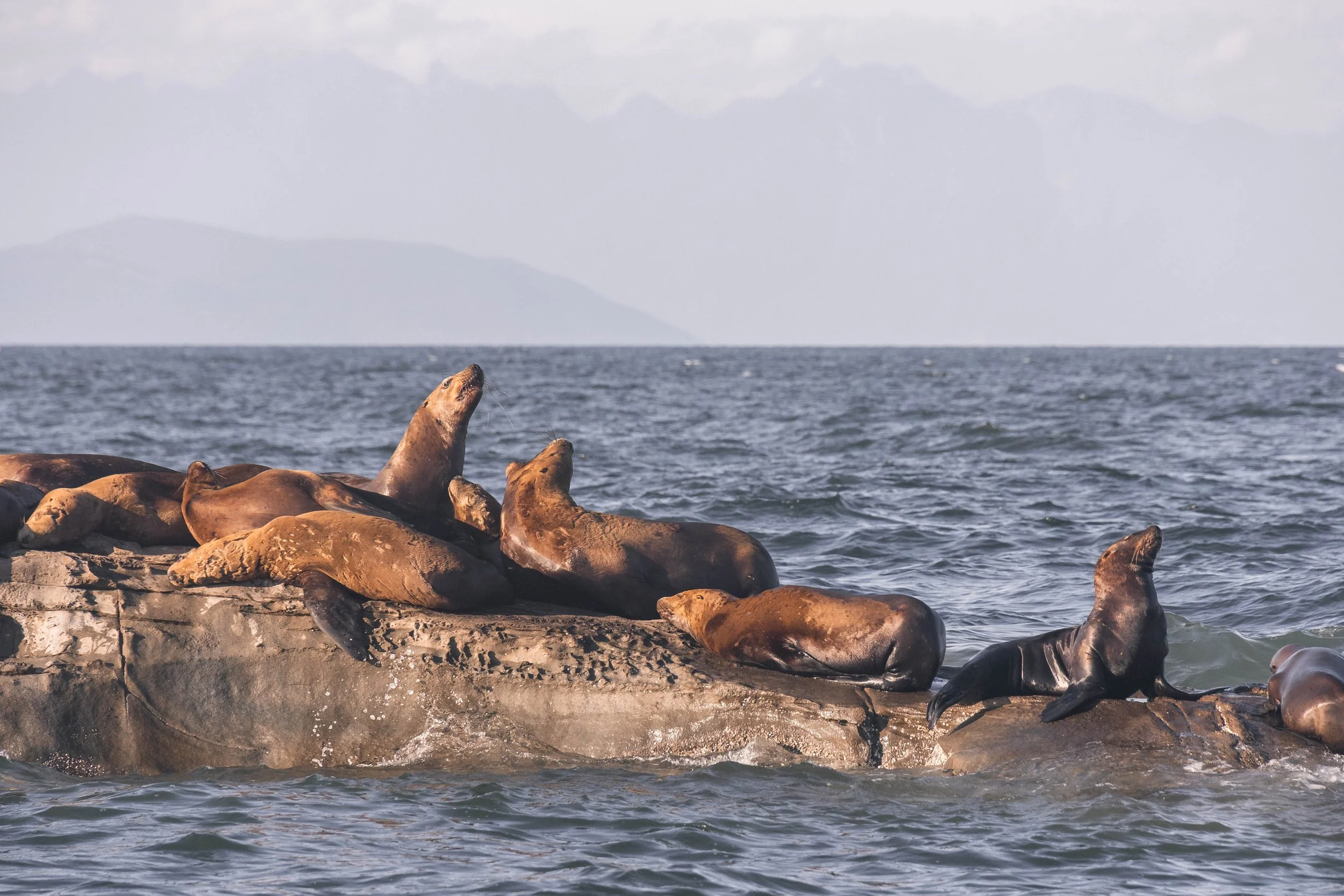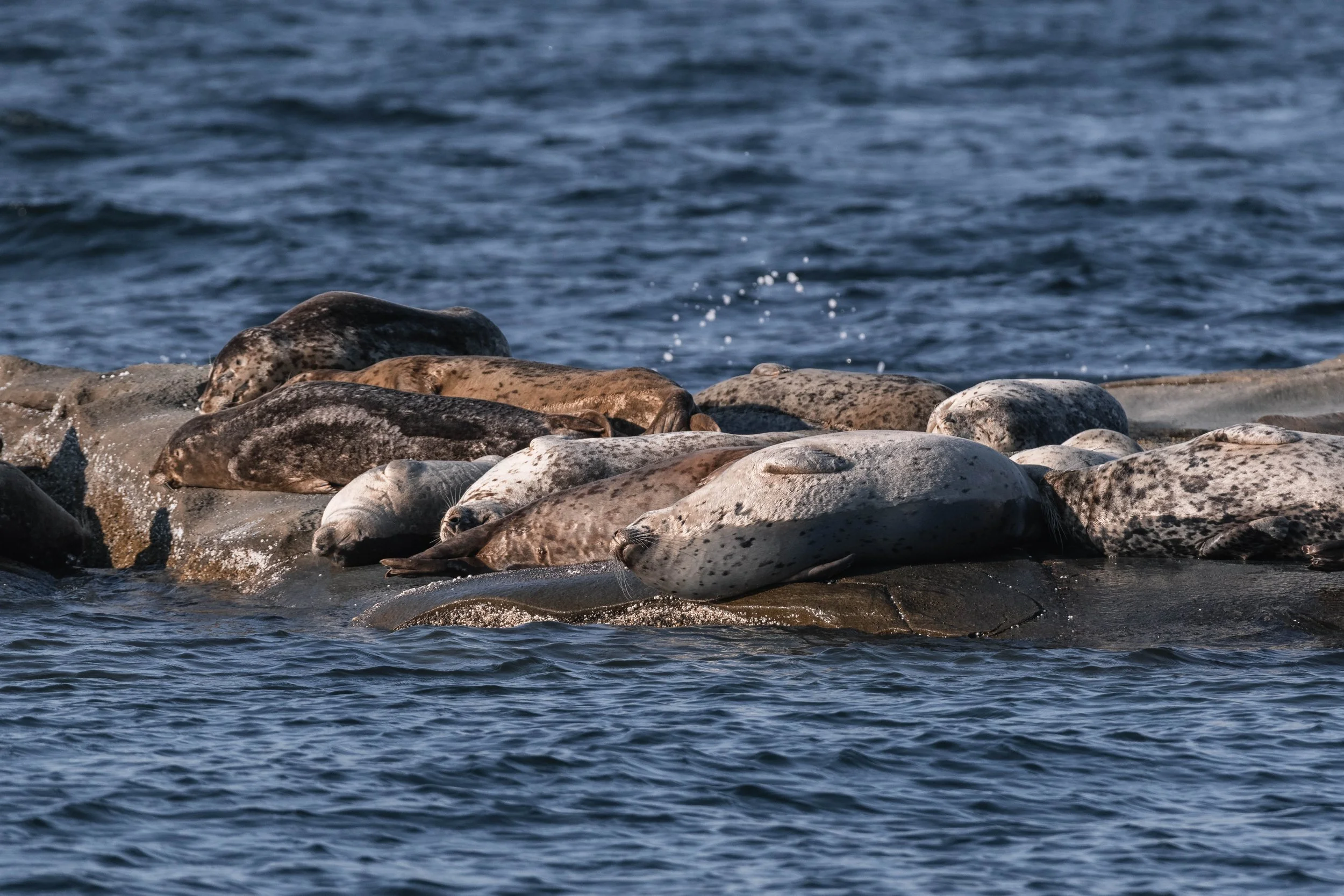July 19, 2025, 3:30 PM - Having a Whale of a Time!
Another adventure awaited us on the Salish Sea this afternoon. We had all three of our boats back out for the afternoon, and they had an idea of where they would be going, since the whales that we had seen this morning were still around. We decided to point that direction, and the adventure began!
We headed into the Strait of Georgia, aiming towards Sturgeon Bank, a shallow sand bar close to Richmond on the mainland. Here we spotted what we were looking for: the T137s moving quickly through the water! This pod consists of 4 members:
T137 Loon ♀ (~1984)
T137A Jack ♂ (2002)
T137B Tempest ♀ (2006)
T137D Wright ♀ (2012)
Nearly every member of this pod had a very distinct notch or two on their dorsal fin, making it very easy to distinguish the individuals. The only one who doesn’t is Tempest, but the lack of a notch is just as telling with this group. These whales started off travelling together, but then they seemed to switch modes from travel to searching for food, as they started moving a bit faster and they spread out a bit. These are Transient, aka Biggs, Orca, and are therefore eating other marine mammals. Most of their food consists of Pinnipeds like the Harbour Seals and Sea Lion species, but they may also try their luck with faster prey like porpoises or dolphins. Once in a while, the smaller species of Baleen Whales, like Minke or Grey, might also become on the menu, but it’s much less common.
We didn’t end up seeing these guys have success in finding anything during the time we spent with them, but that didn’t make it any less enjoyable to see them try! As they picked up the pace, travelling through the waves, we got some great looks at them. There were lots of visible eye patches (the white patch on their face just above and behind their actual eye) and saddle patches to be seen, in addition to their tall dorsal fins. The eye patch is particularly interesting to see, since most of the time they aren’t lifting their rostrums high enough for it to be visible. These eye patches are critical, especially for the transient orca. Since they are eating prey with a lot of fight in them (as we saw later, especially with the sea lions), it can be a bit dangerous! Claws and teeth flashing out at you during a fight in defence can do some significant damage if they land a blow in the right place, especially on vital organs, such as the eye, during hunting. That’s where the eye patches come in. In the heat of a hunt, the prey items will likely lash out at the most obvious eye-shaped thing they see, in this case, the eye patch instead of the eye itself! This theory is supported by the presence of claw scarring in a lot of the eye patches in the whales that we see during our tours.
After spending some time with the T137s, it was time for us to start making our way across the Strait of Georgia once again, aiming towards Valdes Island, where we can usually find some pinnipeds spending time on the rocky outcrops there. As we were travelling, though, we spotted something else: a humpback whale had just surfaced not too far off our path! We decided to head over there to see who was spending their time feeding in the area. Thankfully, they were not doing too deep of dives, but just deep enough that they were still lifting their tail, allowing us to snap some photos! While we weren’t able to figure it out while still on the boats, we reviewed the office and were able to see more detail on the big screen! We determined this humpback whale was Beak/Nuage (BCX1606)!
Beak has a lovely-looking tail, with a large white scar close to the center of his tail. While I would normally say this is very distinct, he actually has a look alike who also likes to spend time in these waters, Seabird! Here are both of their catalogue photos, so you can see how similar they are.
Luckily, even though their scars are similar, there are lots of differences between the two that help distinguish them, especially the shape of their dorsal fins. We didn’t spend too long with Beak before continuing towards Valdes, leaving him to his dinner.
Our final stop of the day was at Stinky Rocks, where we got to see both species of pinniped that are present in our waters this time of the year: the Steller Sea Lions and the Harbour Seals. While both are found in similar areas, they utilize the space slightly differently, avoiding interactions between the two species for the most part. The larger, more maneuverable Steller Sea Lions will be found piled together on the steeper sections of this small island, using their dexterous flippers to walk across the rocks and haul themselves up the slopes. The Harbour Seals, on the other hand, don’t have the ability to rotate their flippers, so movement on land is more restricted. They can’t walk due to this, and instead undulate their bodies for movement in what is called Galumphing! This awkward movement means that they require shallower sloped areas to haul themselves onto the rocks. This being said, there can sometimes be some crossover in the spaces used by each species, so interactions can occur. After our stop at Stinky Rocks, we took the inside of the Southern Gulf Islands home, very happy with all the wildlife we were able to spot today!
The onboard Marine Naturalists, Aly Kohlman, Hayleigh Hilbert, and Jordan Robinson, captured some great shots throughout the adventure, which can be viewed below!
Bald Eagle watching from the treetops. Photo by Aly Kohlman.
An Adult Bald Eagle watching from the tree. Photo by Hayeigh Hilbert.
This juvenile Bald Eagle seemed to be keeping their eye on us. Photo by Hayeigh Hilbert.
T137B Tempest surfacing in the waves. Photo by Aly Kohlman.
Matriarch T137 Loon. Photo by Aly Kohlman.
T137A Jack showing off his eye patch as he breaks through he wave. Photo by Hayeigh Hilbert.
T137B Tempest swimming through the waves. Photo by Hayeigh Hilbert.
T137 Loon surfacing beide daughter T137B Tempest. Photo by Hayeigh Hilbert.
T137 Loon surfacing with T137B Tempest just behind her. Photo by Hayeigh Hilbert.
A great look at T137B Tempest’s eye patch. Photo by Hayeigh Hilbert.
A very cool look at T137B Tempest breaking through the wave. Photo by Hayeigh Hilbert.
You can see the scarring on T137B Tempest’s saddle patch here. Photo by Hayeigh Hilbert.
T137B Tempest breaking through the waves! Photo by Hayeigh Hilbert.
T137A Jack surfacing. Photo by Jordan Robinson.
Beak’s dorsal fin as he surfaces. Photo by Hayeigh Hilbert.
Beak lifting his tail for a dive. Photo by Hayeigh Hilbert.
Beak going for a dive. Photo by Jordan Robinson.
A Steller Sea Lion who is playing mermaid on Stinky Rock. Photo by Aly Kohlman.
This Steller Sea Lion could use a tissue. Photo by Aly Kohlman.
An ichy cuople of Steller Sea Lions. Photo by Hayeigh Hilbert.
Steller Sea Lions on the rocks. Photo by Jordan Robinson.
Some comfortable looking Harbour Seals. Photo by Aly Kohlman.
Look ho happy these two Seal Pups look beside the adults. Photo by Aly Kohlman.
A very fuzzy Harbour Seal. Photo by Hayeigh Hilbert.
A Harbour Seal mom and pup. Photo by Hayeigh Hilbert.
A couple of mom-pup pairs. Photo by Hayeigh Hilbert.










